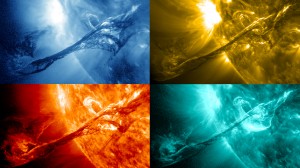
SDO/AIA images of a filament on the sun from August 31, 2012. From upper left and going clockwise: 335, 171, 304 and 131 Å channels
For reasons that are still not fully understood, they can suddenly loose equilibrium and erupt, sending huge amounts of magnetised plasma in the interplanetary space. Solar prominences and the free energy associated with them are closely related to two of the most violent phenomena found in the solar system, namely, Solar Flares and Coronal Mass Ejections (CMEs). Hence, prominence eruptions are often associated to important perturbations of the space environment in the heliosphere, including around the Earth, planets and other solar-system bodies. This is what is called “Space Weather”. Due to these effects, understanding the formation of solar filaments and subsequently the origin of Solar Flares and CMEs is of the utmost importance.
Understanding the role played by solar prominences in Space Weather therefore implies understanding how they are formed, how they evolve, and how (and why) they may erupt. It also implies a good understanding of their association with other solar eruptive events.
Addressing these questions relies on interactions between experts in plasma physics, MHD, magnetic field modelling and observation, spectroscopy, radiation transfer, … The aim of the meeting will be to bring researchers from all these areas to bridge the gap existing between these varied fields of expertise. This will be an excellent opportunity to discuss open issues in this area of interest to solar and stellar physicists, keeping in mind recent and future developments in observations and in modelling.
Invited speakers:
- Brigitte Schmieder (Observatoire de Paris) on Prominence formation and plasma properties
- Spiro Antiochos (NASA/GSFC) on Prominence magnetic field and heliospheric connection
The abstract submission deadline for oral presentations was Sunday 12 January 2014. You can still register and submit poster abstracts.
Registration and abstract submission
When & Where:
Friday, 21st February 2014, 10:30-16:00. Tea and coffee will be provided after the meeting at 16:00.
Organisers: Nicolas Labrosse (University of Glasgow) and Duncan Mackay (University of St Andrews).